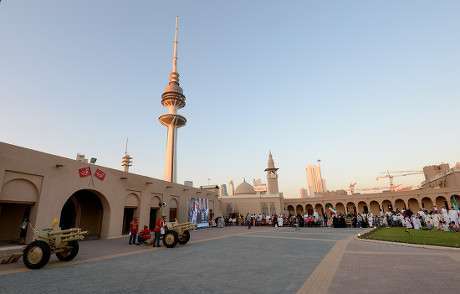Latest News
- Kuwait Arrested 18 Drug Dealers
- 8 More Mental Health Clinics To Be Open
- Fishermen's Makeshift Houses Ordered To Be Removed By Kuwait
- Kuwait Cracks Down On Bachelors
- Non-oil Exports Of Kuwait Reached 106 Million Dinars In January,...
- Kuwait Joins The Global Celebration Of World Press Freedom Day
- Kuwaitis In UAE Advised To Exercise Caution Amid Unstable Weathe...
- MEW Has No Plans For Power Cuts And Is Ready To Tackle The Summe...
- Allow Employees To Transfer If Their Monthly Dues Are Not Paid
- Appeal Court Upholds Death Ruling In Friend’s Kill
- Pakistani Expat Died In A Tragic Accident
- The Hourly Domestic Workers Service Is A New Scam
The Naif Palace Has Been Included In The Islamic Heritage List

During the Heritage Committee's eleventh meeting at the Islamic International, ISESCO decided to designate Kuwait's Naif Palace as an Islamic Heritage Website. Dr Walid Al-Saif, marketing consultant to the secretary-general of Kuwait's National Council for Tradition, Arts, and Letters (NCCAL), claimed that included Naif Palace in ISESCO's Heritage index is of "great historical value, since it's one of the most important Islamic castles."
He also underlined the ancient, political, and cultural significance of location, as well as its architectural assemblage that prompted such an inclusion to ISESCO's heritage inventory. The Palace has a total area of 28,882 square metres and 214 rooms that have been used to store cannons and artillery while other rooms have been utilised to accommodate guards and infantrymen due to its proximity to the town boundaries and primary gate. It's a surprise of Kuwait's antiquities from the first quarter of the twentieth century, with wide open courtyards and massive handcrafted picket doors, as well as Islamic flavour arches around the interior design of the construction.
Ramadan is when this palace is most visible since it is utilized for the fire of the iftar cannon, which has been a tradition in Kuwait since town walls were built. "From both the northern and Japanese sides of the courtyard, you'll view the long liwan with arches and columns of Islamic architectural style." Under the patronage of Sheikh Abdullah Al-Mubarak Al-Sabah and Sheikh Abdullah Ahmad Al-Sabah, the Palace became the headquarters of the Public Security Directorate in 1950, serving as a location to settle disputes, differences, and criminal cases. After all, the conclusion came after two days of sanctioned conversations since the committee thoroughly investigated the palace's ancient significance. - KUNA
Trending News
-
 Expat Residency Law Amended By Kuwait Ministerial...
20 April 2024
Expat Residency Law Amended By Kuwait Ministerial...
20 April 2024 -
 Ministry Announces Separate Time For Amnesty Seeke...
21 April 2024
Ministry Announces Separate Time For Amnesty Seeke...
21 April 2024 -
 The Ministry Connects With Violators Of Residency...
23 April 2024
The Ministry Connects With Violators Of Residency...
23 April 2024 -
 Work Permits Will Be Issued For One Year Under The...
27 April 2024
Work Permits Will Be Issued For One Year Under The...
27 April 2024 -
 AstraZeneca Admits Covid Vaccine Can Cause Rare Si...
29 April 2024
AstraZeneca Admits Covid Vaccine Can Cause Rare Si...
29 April 2024 -
 3 Expats Caught In Salmiya With 213 Bottles Of Loc...
23 April 2024
3 Expats Caught In Salmiya With 213 Bottles Of Loc...
23 April 2024 -
 Temperature Increases Cause Electricity Load Index...
21 April 2024
Temperature Increases Cause Electricity Load Index...
21 April 2024 -
 Al-Nuer Festival Celebrates Kuwaiti Agriculture Wi...
22 April 2024
Al-Nuer Festival Celebrates Kuwaiti Agriculture Wi...
22 April 2024 -
 Peak-time 'cut-offs' Raise Fears Of An Electricity...
22 April 2024
Peak-time 'cut-offs' Raise Fears Of An Electricity...
22 April 2024 -
 Road Trip From Kuwait To Bahrain Via Saudi: Travel...
22 April 2024
Road Trip From Kuwait To Bahrain Via Saudi: Travel...
22 April 2024












Comments Post Comment